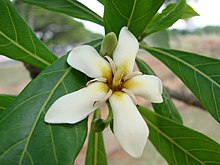Jenipapo
| Jenipapo | ||||||||||||
|---|---|---|---|---|---|---|---|---|---|---|---|---|

right: Jenipapo ( Genipa americana ); left: geniculata |
||||||||||||
| Systematics | ||||||||||||
|
||||||||||||
| Scientific name | ||||||||||||
| Genipa americana | ||||||||||||
| L. |
The genipap tree ( Genipa americana , Syn. : Genipa americana var. Caruto . (Kunth) K.Schum, Genipa caruto Kunth) is a flowering plant in the family of the redness plants (Rubiaceae). The Jenipapo fruit looks like a fig . But it is usually much larger. The Jenipapo tree is widespread in tropical South America , Central America, and the Caribbean .
description
The Jenipapo is an often evergreen , medium-sized tree that reaches heights of 10 to over 20 m and trunk diameters of 30 to 80 cm. The bark is quite smooth and brownish to grayish. The wood is hard and durable, but relatively flexible and white-gray in color.
The relatively short stalked, entire leaves on the branch ends are large. They are slightly leathery, mostly obovate or elliptical, lanceolate and up to 10 to 40 cm long and 5.5 to 19 cm wide. The thick petiole is up to 1 cm long. At the top, the leaves are pointed to pointed, pointed and the veins are pinnate and raised on the underside. The leaves are glabrous on top and slightly hairy on the veins on the underside. There are falling stipules .
In short, terminal and short-stalked zymous inflorescences are the first white and then later yellow, often five-fold and stalked, hermaphrodite flowers that are 2 to 4.5 cm long. There are small bracts . The bald, stiff, fleshy and green calyx is short and cup-shaped with minimal tips. The fine-haired corolla has a shorter corolla tube and longer, elongated and recessed corolla lobes, with an initially yellowish and later dark red area on the inside at the base and in the throat. The stamens in the throat are almost sessile with priemlichen, laid back anthers. The bicameral ovary is below, the slightly conical stigma is long, with two upright lobes that first stand together and then open.
The round or egg-shaped to ellipsoidal, gray-brownish and somewhat rough to scabby-blackish, leathery fruit, berry (armored berry, false fruit ) has a diameter of 6 to 9 cm and the tip is truncated, crater-shaped calyx remains. The relatively dry, whitish pulp surrounds the fruit chambers, which are filled with a multitude of seeds that lie in somewhat slimy membranes. The flattened, light brownish and slightly textured seeds are about 6-10 mm in size. The fruits must be consumed overripe. They are usually harvested not quite ripe and then stored.
use
The ripe, brownish, roughly apple-sized and wrinkled fruits are edible. They are eaten raw or made into compotes, jams or drinks.
The indigenous people of Brazil and Venezuela extract the juice from the green, unripe Jenipapo fruits in order to paint themselves with it, when it comes into contact with the skin it turns blue-black (jagua), which they use similar to Urucú . In Paraguayan folk medicine, Genipa americana ( Guaraní ; Ñandypa ) is said to have disinfectant, laxative, detoxifying and anti-rheumatic effects.
The wood of the tree is used in the area of distribution as construction timber and for furniture.
In 1945 a urologist reports that he was able to synthetically produce a brew that dissolves crusts in the urinary bladder. This brew was originally made from the Buitach apple ( Genipa americana ) by the inhabitants of the Amazon basin and must be drunk hot. It is used by the locals when a candirú (Vandelliinae) has entered the urethra in bathing men to cause the fish's skeleton to dissolve.
swell
- Paul C. Standley: The Rubiaceae of Ecuador. Field Museum of History Botanical Series, Volume VII, Number 2, Chicago, USA, 1931.
- Paul C. Standley: The Rubiaceae of Venezuela. Field Museum of History Botanical Series, Volume VII, Number 4, Chicago, USA, 1931.
- Annals of the Missouri Botanical Garden. Vol. 67, No. 1, 1980, p. 182 ff, online at biodiversitylibrary.org.
- Genipa americana at Smithsonian Tropical Research Institute, accessed September 9, 2019 (more images there in the Digital Archive).
- Genipap at Purdue.
Web links
- Genipa americana at Useful Tropical Plants.
- Genipa americana at NYBG, accessed September 10, 2019 (images).
- Genipa americana at NYBG.
- Description of the species at Raintree - Tropical Plant Database
- The kind of commercial timbers from DELTA
- Information on the species at the US Forest Service (PDF; Engl.)
Individual evidence
- ↑ Manuel de Uso de Hierbas Medicinales del Paraguay on unesco.org.uy (Spanish, PDF; 1.6 MB).
- ^ EE Lin: Solution of Incrustations in Urinary Bladder by New Method. In: The Journal of Urology . 53 (5), 1945, 702.


